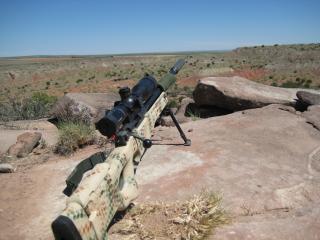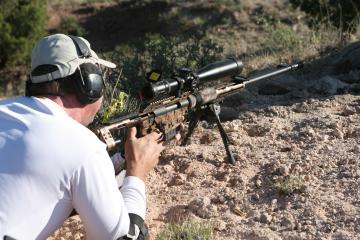
The stage procedure proscribed that shooters come to each station blind, with no notion of where the targets will be located. The range officer (RO) read the written brief from the stage description, and then the shooter had five minutes to locate the targets, identify them to the RO, do range estimation, dope the wind, and make the shot. Each target gets one shot, and that's it-- no alibis, no sighters. The shooter earns one point for each target located and identified, one point for each normal target hit, and three point for each bonus target hit. Many of the stages require some movement to re-engage the same targets again after moving up to ten yards from the original shoot position. Targets on the field courses were generally six or twelve inches across, and were placed as far as 700 yards.

This year the wind conditions were extremely difficult. News reports claimed that the Logan area was getting more wind than it had in decades. Shooters come to expect five to fifteen mph winds, but constant 15 gusting to 35 mph is much more difficult. Temperatures hovered around 100 degrees which combined with the wind for afternoons that felt like standing in front of an open oven. The heat made the match a lot more physically difficult, and the wind made it a lot harder to make hits. 
Watch the Video: Rifle Reliability Highlights from CMG 2008 Steel Safari A variety of rifles, calibers, and scopes were used at the match, however, each competitor had a set of more or less similar gear. First, an accurate rifle critical. Bench-rest accuracy is not required; one MOA is sufficient, one-half preferred. Almost everyone is using their own hand-loads with premium bullets from Sierra, Berger, or Lapua. Ballistic data, or "dope," completes the triad with the rifle and ammunition. Most shooters laminate a small card and tie it to their rifle or scope, or use a retractable "pathfinder" available from Allison Machine Tool or Leupold. Long-range ballistic data isn't useful unless the target distances can be determined, and the best tool for that is a laser range-finder. Since many laser range-finders are monocular units with limited field of view, a good set of binoculars can be a life-saver when trying to find that hidden target. Just about everyone uses a bipod on the rifle, except for the shooters in light rifle class whose rifle could not "make weight" with one installed.
Next is a set of shooting sticks, and a rear bean-bag to help stabilize the butt of the stock while shooting prone. Water is critical because the shooters are on the course for about six hours, and an apple or a Powerbar aren't a bad idea either. Throw everything in a pack and you're set. |